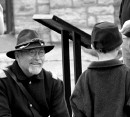NEWS OF 150 YEARS AGO
January-February 1865
From The Missouri Democrat, Monday, February 6, 1865.
FROM WASHINGTON.
The Passage of the Constitutional Amendment—The Scene in the House.
[Special Correspondence to the Cincinnati Gazette.]
WASHINGTON, Feb. 6.
At last the time for the vote had come, and the previous question was demanded. Amid a hush that was painful, the pencils of the clerks noted down the answers to the call. The motion was carried, of course; but—it lacked two of a two thirds vote! A shivering sort of buzz ran through the disappointed galleries; but on the floor the Unionists, though anxious, did not look discouraged, while on the Democratic side could be seen a mingled expression of consternation and defiance. The leaders kept in the back ground; they felt the power of the moment too clearly to think of risking themselves against it; but smaller men made haste to try defeating the inevitable. One proposed adjourning; another laying the motion on the table; a third had a point of order, and a last expedient, flung out as a ruined gamester throws down his last trump card, the threat of filibustering.
All was useless. The majority was ample to press on; it was only on the final vote that the danger came. Men started as Ganson, Radford, Steele and others voted in solid column with the opposition; but they remembered that these were only preliminary motions, and kept hopeful.
At last the critical point was reached. There was a little ripple of debate; a foolish effort to divide the solid Administration ranks by other propositions; when finally the Speaker announced, “The question is, shall the bill pass?” and almost instantly the Clerk was calling, “Allen, Allen, Alley, Allison, Ames, Ancona.” The galleries leaned over with strained attention; Administration members clustered about the several centers where call lists were being noted, and wistfully followed the roll. As the Clerk called “Baldwin” the response came back, quick and sharp, “AYE!” The House broke at once into applause, and the Democrats shouted for order. In a moment Ganson was called and his unexpected “Aye” again evoked applause, not from the galleries, which, not understanding individual positions, were waiting for results, but from the members.
Half a dozen Democrats sprang excitedly to their feet, gesticulating, clamoring for order and shouting at the Speaker, who meantime was thumping with his gavel, and insisting upon quiet in the galleries. “It’s members themselves,” shouted one in his wrath. “It’s on the floor, not in the galleries,” exclaimed another; while all over the Democratic side, enraged members began gesticulating and denouncing the traitors to the party who had evoked the applause that marked the certainty of triumph.
The strained interest on the floor was gone; the buzz of whispering swelled into utter jollity and disorder. Through it all the clerk’s shrill tones cut their way down the roll, and the galleries still leaned over and watched. Two or three more bursts of applause from the floor told how the enemy’s line was breaking, and the popularity that forever follows the mass once more showed itself in hearty clapping of hands as the Speaker quietly said, “Call my name as a member of the House,” and “aye’ answered the Clerk’s call of “Schuyler Colfax.”
There was a moment’s hasty figuring; members were already shaking hands, and almost embracing each other, as they caught enough to see the result, when the tally sheet was handed from the Clerk’s desk to the Speaker.
“On the passage of the joint resolution, the vote is: Yeas, 119; nays 56. The Constitutional two thirds majority having been obtained, the joint resolution is passed!”
What followed—how all rules were forgotten; how nor Speaker, nor opposition, nor even the whole House, could restrain the galleries; how gentlemen cheered, and ladies waved their handkerchiefs, as if muscles and veins were quivering and pulsating with fire; how the flood of great rejoicing swept over and washed out all possible legislative proceeding—all this has already been told a hundred times, and the youngest boy that saw it, will, in his gray hairs, recount the story, in another and better time, to the children of another generation, as the most memorable event of the nation’s history.
“Neither slavery nor involuntary servitude, except as a punishment for crime, whereof the party shall have been duly convicted, shall exist within the United States, or any place subject to their jurisdiction.”
The vision of the great expounder of the Constitution was realized! His eyes were not worthy to see it, but at last the flag does bear, wherever it floats, over the armies that surround the rebellion as with a wall of fire, over the navies that guard the coast, in every land and clime, “LIBERTY AND UNION, ONE AND INSEPARABLE, NOW AND FOREVER!”
AGATE.


